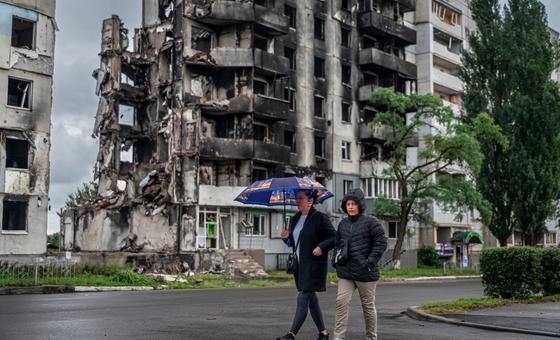Manfred Profazi, who is based in Vienna, Austria, has been touring some of the regions in Ukraine which have been most seriously affected by over 13 months of conflict following Russia’s full-scale invasion.
He has told UN News what he’s been seeing across the devastated country and how IOM has provided comfort to people forced to flee their homes due to the fighting and bombardment of civilian areas.
“Travelling in Ukraine these days isn’t easy. When I served as Chief of Mission for the International Organization for Migration from 2012 to 2017 it was possible to fly, or take one of the modern trains across the length and breadth of this vast country.
Now flying is completely impossible, and travel by train still fraught.
My journey this week in Ukraine, from Odesa and Mykolaiv in the south, Dnipro in the East, up to the capital Kyiv and again west to Lviv, was, for security reasons, by road.
It gave me ample time to reflect on my own journey and the millions of individual journeys that have been taken since the start of the war, and indeed before.
Millions of people are in state of flux, caught between being displaced in their own land, or with their families torn apart. Some stay in Ukraine because they cannot leave the land that bore them, some because leaving is not an option, some, of course, stay to fight.

A group of mainly women and children arrive in Kyiv in April 2022 after being evacuated from the southern city of Mykolaiv.
Some 5.4 million people are displaced in Ukraine, and more than eight million have fled across its borders, but it’s impossible to estimate how many million journeys have been undertaken. Many people have been displaced several times. Some have travelled abroad, come back, settled, and left again as the fighting swings this way and that.
This feeling of dislocation affects even communities and people that have not relocated. Communities have been crushed, unsettled, scattered. The damage in places like Mykolaiv, and countless small towns and villages I passed through this week, scars the landscape and the emotions.
Who would not want to flee such a nightmare?
Rising from the rubble
And yet, people stay. People are returning. People are adapting to being in new host communities, and are bringing their skills and their experience to help rebuild their nation. Their homeland.
Of course, rebuilding and reconstruction in the middle of a war is challenging, to put it mildly, but everywhere I went, I saw new infrastructure rising from the rubble. Much of it, I am proud and humbled to say, has been installed by IOM and by organizations working with us, and with local authorities, who have done so much to keep hope alive.
One of many examples is a mobile heating plant, essentially the hangar of a 40-tonne truck, specially adapted to provide heat to a children’s hospital, where hundreds of children – local and displaced – can receive uninterrupted treatment.

IOM Regional Director Manfred Profazi talks to Valeria about her life as a resident in an IOM-supported dormitory in Dnipro.
“I was lucky enough to be able to hear first-person accounts of survival, of resilience and even optimism from young and old alike. These stories, and the dedication of our staff, keep all of us motivated and focussed on our assistance, and on facilitating recovering without fostering dependency.
I’m thinking of Valeriia and her son, who fled the destruction of Bakhmut and are now finally in decent accommodation, thanks to IOM-organized repair works to a dormitory in Dnipro.
She showed me photos of her home, now completely destroyed, and spoke wistfully of her market garden. Now she grows a few greens in a window box. Her son, a diligent student, follows his lessons on a mobile phone, as he doesn’t even have a laptop. They have not given up; they do whatever it takes to retain a simulacrum of normal life.
IOM’s integrated approach allows us to support displaced people and host communities on multiple levels and provide them with a full range of services from infrastructure to income-generation.

The International Organization for Migration (IOM) is stepping up efforts to help displaced and war-affected people cope with cold weather.
I was Chief of Mission at IOM Ukraine in 2014 when armed conflict in Donbas broke out between Ukraine and separatists; this caused the first wave of displacement. Back then we built the technical know-how and a close relationship with local and central government that stood us in good stead as we scaled up to meet these massive new challenges.
I would like to say there is a light at the end of the tunnel, but, as they say, “prediction is very difficult, especially if it’s about the future”. One thing is sure, there is light IN the tunnel, the light that comes from the resilience, the resolution, even the obduracy of the Ukrainian people, who refuse to submit to despair.
We will continue our efforts to support these people as long as needed in all the ways we can.”
Read more here, about the work of IOM in Ukraine.

